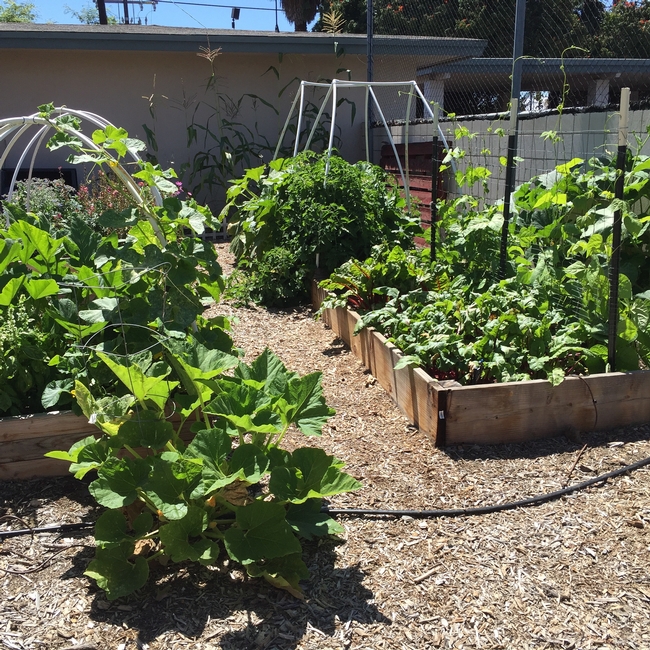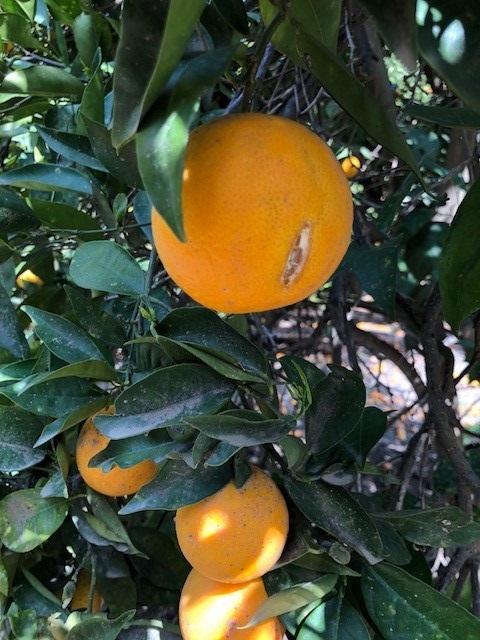
Posts Tagged: fruit trees
Celebrate Earth Day with Gardening and Other Stay-at-Home Resources
This week marks the 50th anniversary of Earth Day. This year, consider celebrating the day with gardening and other stay-at-home resources curated by your local UCCE office.
History of Earth Day
Earth Day was launched in 1970. Many factors contributed to the call for a national day focusing on environmental stewardship, including the publication of Rachel Carson's Silent Spring - serialized in the New Yorker - and the catastrophic oil spill that occurred off the coast of Santa Barbara in 1969. The Santa Barbara oil spill galvanized U.S. Senator Gaylord Nelson (D-Wisconsin) to call for a national day of locally inspired and organized "teach-ins" on the environment - a national "Earth Day." The Earth Day model was inspired by the spirit of campus activism at the nation's colleges and universities. It wasn't top-down, but rather a grassroots effort that encouraged communities to develop educational and service events around issues and topics important to them.
Earth Day struck a chord; some estimates suggest that 1 in 10 Americans participated in the first events. Earth Day is widely credited with "sparking" the modern environmental movement. Landmark environmental legislation swiftly followed (including the Clean Air Act, Clean Water Act and Endangered Species Act). The Environmental Protection agency was founded that same year. Twenty years after its launch, Earth Day became a global movement.
You can learn more from the Earth Day Network by linking to this website.
Home Garden Resources
There is a wave of renewed interest in gardening as a result of the COVID-19 pandemic. Learn more about "crisis" gardening - and a new "Victory Garden" movement - in this article from the New York Times.
Closer to home, we have a wealth of gardening resources for you.
One of our favorites is the California Garden Web, designed by our UC Master Gardeners. You'll find a wealth of gardening information and a helpful glossary.
Ventura County is blessed with a wonderful growing climate and many of us have backyard fruit trees. Learn more about cultivating and caring for your home orchard here.
Resources for the Home Classroom
Many of us are working with our children in home classrooms. The UC 4-H Youth Development Program has a range of resources available to engage young learners. In honor of Earth Day, take a look at our 4-H Vegetable Gardening Project sheet. We also recommend our 4-H Water Conservation Project sheet, which provides engaging, science-based activities the entire family can enjoy. 4-H is one of the oldest youth development programs in the nation and we'll be sharing other educational resources in upcoming posts. #Head #Heart #Hands #Health.
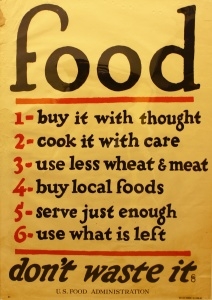
Be Kind to the Earth by Reducing Food Waste
Nearly 40 percent of the food produced in the U.S. is wasted and much of that waste ends up in landfills (definitely not good for our environment or the economy).
The National Resources Defense Council estimates that the average family of four throws out nearly 1,000 pounds of food each year, wasting roughly $1,500.
Consumers as a group waste more food than farms, grocery stores or restaurants. For tips on ways you can reduce #FoodWaste, click here.
History lesson: The image on the left is a poster that was used during World War I and World War II to promote food conservation. First printed in 1919, it contains tips that are helpful today.
This image is from a collection held by the Museum of County. Photographer: Aysen Tan.
Related reading: What a World War I Poster Can Teach Us About #FoodWaste.
Thank you, Volunteers!
This week is National Volunteer Week and we want to thank the hundreds of volunteers who are part of UCCE Ventura...and who make our work possible. Thanks to our 4-H, Master Gardener and HAREC volunteers. You are central to our mission and we value you. Youth, Families and Communities Education Program Manager Susana Bruzzone-Miller created this video to express our appreciation.
COVID-19 Resources
Our COVID-19 landing page provides links to important resources about the pandemic, including information for the agricultural community. In response to the coronavirus (COVID-19) illness, our office is closed for face-to-face service through May 15th. While we regret the inconvenience, these are the precautions we are taking to support one other and comply with University, local, county and state government recommendations. Our staff is telecommuting and can be contacted via phone and email. We are here to serve you.
Stay safe.
Thank you UC HAREC Volunteers
Will Deciduous Fruit Trees Flourish in Ventura in 30 Years?
That's a good question. Some question whether they flourish now. Southern California does not have the landscapes of apples, pears and peaches of Oregon, Michigan, Pennsylvania or even Fresno, but there are nice little niches of persimmon, low chill apple, and even blueberries that thrive in the lower winter chilling environments along the coast and in the south of California.
Here is an example of what might happen to this fruit industry here. A recent, detailed study extrapolate the accumulation of cold periods in Spain over the next 30 years and to the end of the century. This provides growers with important information on the viability of future fruit cultivation in the various Spanish regions, as it allows them to know if there will be the necessary accumulated cold for the fruits to grow correctly or if they should relocate their crops to other areas.
The results obtained show a general reduction in the accumulation of cold in any future period for all the chilling models and scenarios considered. The reduction is especially significant at the end of the century, under the most pessimistic scenario. These results invite us to strongly commit, not only to adapt but also to mitigate climate change, something that would make an important difference. The probable reduction of cold would threaten the viability of some varieties of fruit trees in the near future, especially in regions where there is currently a low accumulation of cold and there are varieties that require a lot of it.
The study can be viewed at:
https://www.nat-hazards-earth-syst-sci.net/19/1087/2019/
Climate change discussions for California can be found at these websites:
https://ucanr.edu/blogs/blogcore/postdetail.cfm?postnum=30513
https://ucanr.edu/blogs/blogcore/postdetail.cfm?postnum=28175
An intriguing Santa Barbara apple study grower's observations are worth noting: https://ucanr.edu/blogs/Topics/index.cfm?start=1&tagname=apples
By the way the 'Moor Park' apricot is not from Moorpark, CA, but from England and the variety has never done very well in Moorpark (http://www.ngr.ucdavis.edu/treedetails.cfm?v=997).

apple image 2
What Winter? Not Cold Enough for Apricot, Too Warm for Valencia
So, there are peach trees right now that are flower-less and leaf-less. Wisteria which should have flowered in February is bare. The Royal apricot next door has no flower. The Lombardy poplars and birch in Oxnard don't have leaves. Spring is here, grass is growing, but many deciduous trees are still leafless and haven't flowered? What is going on?
Deciduous fruit trees and many landscape trees like poplar, birch, willow and sycamore, etc. must go through a dormant period each winter in preparation for producing fruit and leaves the following spring and summer. This rest period, also known as a chilling period, is directly related to winter temperatures. For many varieties of trees, the most efficient temperature for chilling is 45°F, with little additional chilling effect at temperatures below 32°F. Brief warm spells in winter have a negative effect — temperatures above 70°F for four or more hours offset any chilling that happened in the previous 24-36 hours.
Once chilling is complete, the trees prepare to wake up from dormancy and bud after a certain amount of warming takes place. The amount of required warming is cumulative, measured by counting the number of degrees each day above a threshold temperature, usually 40°F. This cumulative warming, combined with how well the tree met its chilling requirement over the winter, determines whether a tree buds early or late in the spring.
Tables and charts have been developed for different chilling requirements of fruit trees. The number of hours needed at or below 45°F varies with the type of tree:
- Peach: 400 to 1050 hours
- Apple: 800 to 1100 hours
- Cherry: 1000+ hours
But in coastal Southern California, those hours are never achieved. You need to go to Santa Ynez to get close to those hours. More typically in the Santa Paula, Santa Barbara, San Luis Obispo area, the chilling hours below 45 are close to 200 and lower in many years. Some years there is more, some years less. How temperatures above 70 affect chilling aren't always clear. As a result there are several different ways to account for chilling and none of them work very well for the coast./
Fortunately, we have low-chill varieties of many fruit trees that will produce with lower chilling. So ‘Anna' apple and ‘Royal' apricot do well, and many landscape trees are adapted to the lower winter chilling along the coast and do well. Low chill blueberries thrive to the point that in many years, they don't even go dormant.
This year the warm, cold, warm, cold pattern has mixed trees up. There are some deciduous trees that are doing fine, while others still have not flowered and leafed out. The mix of temperatures is not following the traditional patterns used to calculate chilling requirement. The trees are following their own pattern.
In the last several years in Southern California, winters have seemed shorter and milder, resulting in earlier springs. Trees that have flourished in a location could have decreasing yields in the future, and the favorable locations to grow these fruit trees could shift.
The Fruit and Nut Center at UC Davis has a link to the CIMIS system operated by the CA Dept of Water Resources. The site has various methods of calculating chilling hours, none of them seem adequate though for describing what is happening in the landscape today in Southern California
http://fruitsandnuts.ucdavis.edu/Weather_Services/chilling_accumulation_models/
Look at it to see if you can see a new way of understanding deciduous tree response to the weather.
Just got a call recently that 'Valencia' oranges are splitting. This normally happens to ripe 'Navels' that are over mature and get erratic winter irrigation, especially during drought. In this case, the 'Valencias' are advanced in maturity because of the warm winter, probably advanced by two months. Again erratic watering has probably lead to this splitting.
What a crazy winter.
Splitting coastal 'Valencia' oranges in April, 2018
photo: Peaches without adequate chilling.
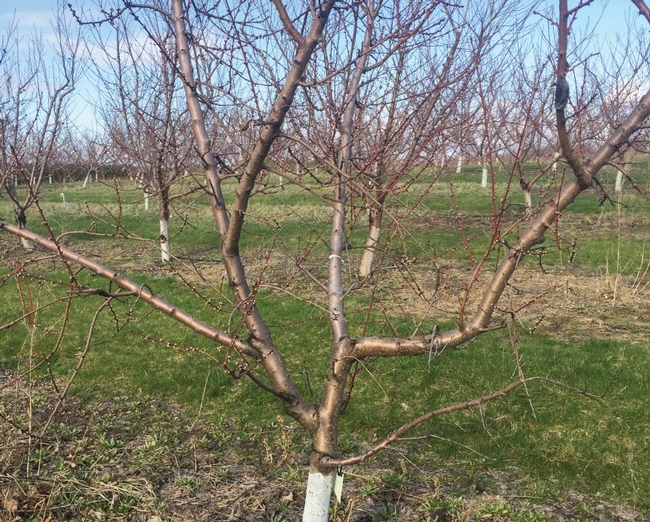
no chill peach
HLB Tree Confirmed in Riverside
The California Department of Food and Agriculture (CDFA) and the United States Department of Agriculture (USDA) have confirmed the detection of the citrus disease known as Huanglongbing (HLB), or citrus greening, in Riverside County. The disease was detected in plant material taken from a grapefruit tree in a residential neighborhood in the city of Riverside near I-215.
The infected tree has been removed and agriculture officials are moving swiftly on mandatory surveying in an 800-meter area. Mandatory treatments will soon follow. CDFA staff will visit all regulated entities in the quarantine area, including retail and production nurseries and packinghouses. Additionally, local, state and federal agriculture authorities are working together to determine potential implications to the University of California, Riverside, which will fall within the 5-mile quarantine area.
Riverside County Agricultural Commissioner/Sealer Ruben Arroyo plans to take an aggressive stance on any abandoned groves in the area, and the Citrus Pest & Disease Prevention Program outreach team is already working with the City of Riverside to inform residents of the actions needed to stop HLB's spread.
Please read the full press release shared on July 25 by Riverside County.
For more information about ACP or HLB, Riverside County residents may call the Agricultural Commissioner's Office at (951) 955-3045 or CDFA's toll-free pest hotline at 1-800-491-1899 or visit: www.cdfa.ca.gov/plant/acp/

HLB symptoms
A New Posting of the Topics in Subtropics Newsletter
Here's the Fall newsletter of Topics in Subtropics, and it is on time. Winter hasn't started yet, but get ready.
And the topics are:
- Real-Time Sensor for Early Detection of Citrus Huanglongbing (HLB)
- The 2016 International Citrus Conference
- UC Riverside Scientists Evaluate Trunk Injections of Pesticides for The Management of Ambrosia Beetles in California Avocados
- An Overview of Mango
- Water Based Latex Paint as a Means to Track Ambrosia Beetle Activity on Infested Trees
http://ceventura.ucanr.edu/newsletters/Topics_in_Subtropics66242.pdf
To subscribe:
http://ceventura.ucanr.edu/Com_Ag/Subtropical/

topics
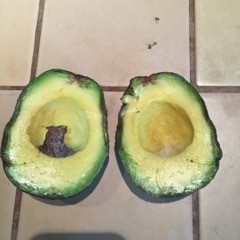
avocado body rot2

